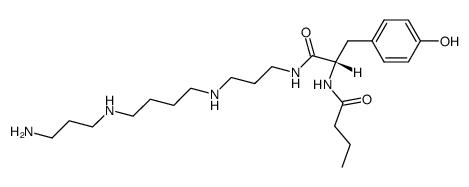Multiple actions of arylalkylamine arthropod toxins on the N-methyl-D-aspartate receptor.
S D Donevan, M A Rogawski
文献索引:Neuroscience 70(2) , 361-75, (1996)
全文:HTML全文
摘要
The effects of the arylalkyamine arthropod toxins argiotoxin 636 and philanthotoxin 343 were studied on N-methyl-D-aspartate receptor currents in cultured rat hippocampal neurons using whole-cell recording techniques. Argiotoxin 636 and philanthotoxin 343 blocked 10 microM N-methyl-D-aspartate (+10 microM glycine) currents in a concentration-dependent fashion (steady-state IC50 values, 0.9 and 56 microM, respectively). The onset and recovery from argiotoxin 636 block occurred slowly (forward and reverse rate constants, 7.5 x 10(3) s-1 M-1 and 6.9 x 10(-3) s-1, respectively) whereas the philanthotoxin 343 block was more rapid (forward and reverse rate constants, 1.1 x 10(5) s-1 M-1 and 0.1 s-1). A portion, but not all, of the block by the two toxins could be reversed by depolarization to positive holding potentials, indicating that there are voltage-dependent and non-voltage-dependent components of the block. The long-lasting argiotoxin 636 block at -60 mV occurred in a use-dependent fashion and could be substantially reduced by co-application with 10 mM Mg2+, providing evidence that the toxin has a channel blocking action. In contrast to the use dependence of the voltage-dependent argiotoxin 636 block, the non-voltage-dependent component of block (at +60 mV) did not require agonist gating of the channel. The non-voltage-dependent block by argiotoxin 636 was unaffected by increasing the glycine concentration, but was reversed by increasing the N-methyl-D-aspartate concentration, suggesting that the toxin may act as a competitive antagonist at the N-methyl-D-aspartate recognition site. This mechanism was further supported by the near identity of the time constant for argiotoxin 636 block with the time constant for agonist dissociation, irrespective of whether the rapidly dissociating agonist N-methyl-D-aspartate or the more slowly dissociating agonist glutamate was used. With high concentrations of N-methyl-D-aspartate (> or = 100 microM), argiotoxin 636 produced a potentiation of the peak N-methyl-D-aspartate response (at +60 mV) that was accompanied by a slowing in the rate of current desensitization and an increase in the affinity for glycine. We conclude that the arylalkylamine toxins antagonize N-methyl-D-aspartate receptor currents by two distinct mechanisms: use-dependent and voltage-dependent open channel block and competitive antagonism at the N-methyl-D-aspartate recognition site. In addition, argiotoxin 636 exerts a polyamine-like facilitation of N-methyl-D-aspartate receptor currents. This facilitation occurs via both the glycine-dependent and glycine-independent mechanisms, whereby spermine is known to potentiate N-methyl-D-aspartate receptor responses.
相关化合物
| 结构式 | 名称/CAS号 | 分子式 | 全部文献 |
|---|---|---|---|
 |
Philanthotoxin 343
CAS:115976-93-7 |
C23H41N5O3 |
|
Open-channel blockade is less effective on GluN3B than GluN3...
2012-07-05 [Eur. J. Pharmacol. 686(1-3) , 22-31, (2012)] |
|
Neuroactive polyamine wasp toxins: nuclear magnetic resonanc...
1996-01-19 [J. Med. Chem. 39(2) , 515-21, (1996)] |
|
A sequential high-yielding large-scale solution-method for s...
2003-01-01 [Eur. J. Med. Chem. 38(1) , 117-22, (2003)] |
|
Potent and voltage-dependent block by philanthotoxin-343 of ...
1997-09-01 [Br. J. Pharmacol. 122(2) , 379-85, (1997)] |
|
Possible influence of intramolecular hydrogen bonds on the t...
2000-01-01 [Receptors Channels 7(3) , 227-36, (2000)] |